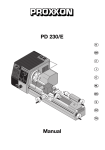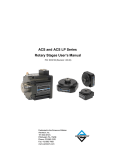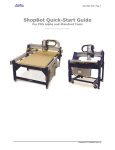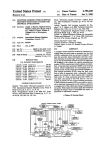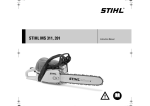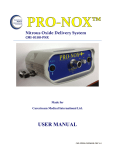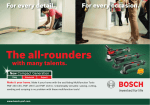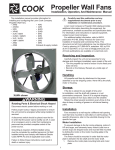Download Contents Foreword
Transcript
Contents Foreword Page 5 Dear Customer, Legend 6 Description of the machine 7 Technical data 8 By purchasing your PROXXON Lathe PD 230/E, you have chosen a good-quality, high-grade machine. The latest production and testing methods guarantee a high level of reliability for this machine. Installation and setting up 8 This instruction manual covers: Switching on the machine 8 • safety regulations Operating the handwheels 8 • operation and maintenance Switching on the automatic feed 8 • spare parts list Working with the tailstock 9 Selecting the turning tool 9 Please read carefully! 9 Using this instruction manual will Foreword Safety regulations Inserting the turning tool in the tool holder Setting the spindle speeds 10 Calculating the maximum spindle speed 10 Clamping the work piece in the lathe chuck 10 Turning the jaws of the lathe chuck 10 Longitudinal turning 11 • make it easier for you to get used to the machine, • help prevent faults occurring due to improper use and • increase the service life of your machine. Keep this instruction manual in an easily accessible place. Only operate this machine if you are qualified to do so and follow the guidelines in this instruction manual. Face turning 11 Taper turning 11 Cutting off a work piece 11 PROXXON does not accept responsibility for the safe functioning of the machine Fitting change gears for thread cutting 11 • if it is handled in a manner which constitutes improper use, Thread cutting with the turning tool 12 Thread cutting using the top slide 12 • if it is used for other purposes which are not specified in the instruction manual, Cutting left threads 12 • if the safety regulations are not observed. Accessories for Lathe PD 230/E 13 Installing the centre lathe 13 Removing the centre 13 Four-jaw chuck 13 Fastening the drill chuck 13 In the interests of your safety, please always observe the safety regulations. Fixed steady 14 Only use genuine PROXXON spare parts. Maintenance 14 General 14 We reserve the right to make further alterations for the purpose of technical progress. Setting the guide play 14 Spare parts list 15 Warranty claims are invalid if • the machine is incorrectly operated, • the machine has not been sufficiently maintained. We wish you every success with your machine. -5- Safety regulations IMPORTANT • Ensure the workplace is tidy. • Check the unit for damage before use. • (connection cable, protective devices, etc.), have defective parts replaced by qualified personnel. • This unit corresponds to the pertinent safety regulations. Repairs (e.g., replacement of the power supply lead) may only be performed by a qualified electrician. • Never work without the safety equipment fitted. • Do not use electrical power tools in the rain, in damp surroundings or in the vicinity of flammable liquids or gases. • Only use the tool when the handle is dry and free from grease. • Avoid contact with earthed components, e.g., pipes, radiators, ovens and refrigerators. • Protect the connection lead from heat and sharp edges and route it so it cannot be damaged. • Do not remove the plug from the socket by pulling on the cable. • Do not pick up the unit by the cable. • Keep children and third parties away from the workplace. • Keep tools in childsafe locations when not in use. • Do not overload the tool. • Do not use the tool to perform operations for which it is not suitable. • Replace blunt tools in good time. • Visually inspect application tools to ensure they are in good working order and suitable for the task prior to setting up the job. • Fasten tools securely. • Clean the unit thoroughly following all work. • Disconnect the plug from the power supply when the unit is not in use, before performing maintenance, tool replacement or repair work. • Only plug the unit in when the unit is switched off. • Always wear protective goggles (danger of tool breakage). • If necessary, wear a protective dust mask. • Only use appropriate working clothes (no loose sleeves, ties, jewellery). • Wear a hair net if you have long hair. • Only use accessories and spare parts recommended by PROXXON. • Observe the max. permitted rotational speed. • If necessary, use dust extract equipment. • Do not use the tool when you are tired or under the influence of alcohol. • Keep fingers away from rotating or fast moving tools (saws, etc.). • Keep the operation instructions in a safe place. -6- General safety instructions Read and become familiar with this entire instructions manual. Learn the tool`s applications, limitations and possible hazards. 1. KEEP GUARDS IN PLACE and in working order. 2. REMOVE ADJUSTING KEYS AND WRENCHES. Form habit of checking to see that keys and adjusting wrenches are removed from tool before turning it on. 3. KEEP WORK AREA CLEAN. Cluttered areas and benches invite accidents. 4. DON'T USE IN DANGEROUS ENVIRONMENT. Don't use power tools in damp or wet locations, or expose them to rain. Keep work area well lighted. 5. KEEP CHILDREN AWAY. All visitors should be kept safe distance from work area. 6. MAKE WORKSHOP KID PROOF with padlocks, master switches, or by removing starter keys. 7. DON'T FORCE TOOL. It will do the job better and safer at the rate for which it was designed. 8. USE RIGHT TOOL. Don't force tool or attachment to do a job for which it was not designed. 9. USE PROPER EXTENSION CORD. Make sure your extension cord is in good condition. When using an extension cord, be sure to use one heavy enough to carry the current your product will draw. An undersized cord will cause a drop in line voltage resulting in loss of power and overheating. Table 1 shows the correct size to use depending on cord length and nameplate ampere rating. If in doubt, use the next heavier gage. The smaller the gage number, the heavier the cord. Exception No. 1: The reference to the table and the table itself may be omitted if a statement indicating the appropriate gage and length is incorporated into the instruction. Exception No. 2: The information regarding extension cords need not be provided for a permanently connected tool. 10. WEAR PROPER APPAREL. Do not wear loose clothing, gloves, neckties, rings, bracelets, or other jewelry which may get caught in moving parts. Non-slip footwear is recommended. Wear protective hair covering to contain long hair. Exception: The reference to gloves may be omitted from the instructions for a grinder. 11. ALWAYS USE SAFETY GLASSES. Also use face or dust mask if cutting operation is dusty. Everyday eyeglasses only have impact resistant lenses, they are NOT safety glasses. 12. SECURE WORK. Use clamps or a vise to hold work when practical. It's safer than using your hand and it frees both hands to operate tool. 13. DON'T OVERREACH. Keep proper footing and balance at all times. 14. MAINTAIN TOOLS WITH CARE. Keep tools sharp and clean for best and safest performance. Follow instructions for lubricating and changing accessories. 15. DISCONNECT TOOLS before servicing; when changing accessories, such as blades, bits, cutters, and the like. 16. REDUCE THE RISK OF UNINTENTIONAL STARTING. Make sure switch is in off position before plugging in. 17. USE RECOMMENDED ACCESSORIES. Consult the owner's manual for recommended accessories. The use of improper accessories may cause risk of injury to persons. 18. NEVER STAND ON TOOL. Serious injury could occur if the tool is tipped or if the cutting tool is unintentionally contacted. 19. CHECK DAMAGED PARTS. Before further use of the tool, a guard or other part that is damaged should be carefully checked to determine that it will operate properly and perform its intended function check for alignment of moving parts, binding of moving parts, breakage of parts, mounting, and any other conditions that may affect its operation. A guard or other part that is damaged should be properly repaired or replaced. 20. DIRECTION OF FEED. Feed work into a blade or cutter against the direction of rotation of the blade or cutter only. 21. NEVER LEAVE TOOL RUNNING UNATTENDED. TURN POWER OFF. Don't leave tool until it comes to a complete stop. Warning Table 1 Additional safety instructions for lathes: For Your Own Safety Read Instruction Manual Before Operating Lathe a) Wear eye protection. b) Do not wear gloves, necktie, or loose clothing. c) Tighten all locks before operating. d) Rotate workpiece by hand before applying power. e) Rough out workpiece before installing on faceplate. f) Do not mount split workpiece or one containing knot. g) Use lowest speed when starting new. GROUNDING INSTRUCTIONS: 1. All grounded, cord-connected tools: In the event of a malfunction or breakdown, grounding provides a path of least resistance for electric current to reduce the risk of electric shock. This tool is equipped with an electric cord having an equipment-grounding conductor and a grounding plug. The plug must be plugged into a matching outlet that is properly installed and grounded in accordance with all local codes and ordinances. Do not modify the plug provided -- if it will not fit the outlet, have the proper outlet installed by a qualified electrician. Improper connection of the equipment-grounding conductor can result in a risk of electric shock. The conductor with insulation having an outer surface that is green with or without yellow stripes is the equipment-grounding conductor. If repair or replacement of the electric cord or plug is necessary, do not connect the equipment-grounding conductor to a live terminal. Check with a qualified electrician or service personnel if the grounding instructions are not completely understood, or if in doubt as to whether the tool is properly grounded. Use only 3-wire extension cords that have 3prong grounding plugs and 3pole receptacles that accept the tool's plug. Repair or replace damaged or worn cord immediately. 2. Grounded, cord-connected tools intended for use on a supply circuit having a nominal rating less than 150 volts: This tool is intended for use on a circuit that has an outlet that looks like the one illustrated in Sketch A in Figure 28. The tool has a grounding plug that looks like the plug illustrated in Sketch A in Figure 28. A temporary adapter, which looks like the adapter illustrated in Sketches B and C, may be used to connect this plug to a 2-pole receptacle as shown in Sketch B if a properly grounded outlet is not available. The temporary adapter should be used only until a properly grounded outlet can be installed by a qualified electrician. The green-colored rigid ear, lug, and the like, extending from the adapter must be connected to a permanent ground such as a properly grounded outlet box. Minimum gage for cord Effective date for Table 1 changed from November 1, 1995 to November 11, 1996 Ampere Rating More Than Volts Total length of cord in feet 120 V 25 ft. 50 ft. 100 ft. 150 ft. 240 V 50 ft. 100 ft. 200 ft. 300 ft. Not More Than AWG 0 6 18 16 16 14 6 10 18 16 14 12 10 12 16 16 14 12 12 16 14 12 Not Recommended Legend (Fig. 1) 1. Main spindle 2. Lathe chuck 3. Turning tool holder 4. Rotating centre 5. Flange surface for milling unit 6. Sleeve 7. Clamp screw for sleeve 8. Tailstock 9. Sleeve adjusting handwheel 10. Handwheel for leadscrew 11. Clamp screw for tailstock 12. Leadscrew 13. Adjusting handwheel for top slide 14. Top slide 15. Support 16. Cross-slide 17. Adjusting handwheel for cross-slide 18. Clutch switch for automatic feed 19. Drive gearbox cover with speed table Grounding methods 20. Switch for anticlockwise rotation stop clockwise rotation 21. Main switch 22. Function display 23. Control 24. Hollow hexagon wrench METAL SCREW 25. Open-ended wrench COVER OF GROUNDED OUTLET BOX GROUNDING PIN 26. Lathe chuck wrench <B> <A> ADAPTER <C> GROUNDING MEANS GROUNDING PIN <D> Fig. 28 -7- Description of the machine Installation and setting up The PROXXON lathe PD 230/E is an extensible system which consists of • solid shaft electronics for high torques over the entire speed range • automatic feed • lathe chuck and • rotating centre for machining steel, brass, aluminium and plastics. It can also be used for face turning, longitudinal turning and metric as well as inch system based thread cutting. The machine is also suitable for boring, milling work and grooving by using the appropriate accessories. The ribbed, grey cast iron machine bed with ground prismatic guideways ensures vibration-free work. Warning To avoid injury from unexpected starting or electrical shock, do not plug the power cord into a power source receptacle during unpacking and assembly. This cord must remain unplugged whenever you are working on the lathe. If any part is missing or damaged, do not plug the lathe in until the missing or damaged part is replaced, and assembly is complete. To avoid electrical shock, use only identical replacement parts when servicing grounded tools. The standard equipment of the PROXXON Lathe PD 230/E consists of the following parts: • lathe complete with motor, automatic feed and three jaw chuck with chuck wrench • rotating centre • tool kit • change gear kit for thread turning • tool holder. Warning This Lathe is for indoor use only. Do not expose to rain or use in damp locations. Do not attempt to modify this tool or create accessories not recommended for use with this tool. Any such alternation or modification is misuse and could result in hazardous condition leading to possible serious injury. Technical data: Centre distance 230 mm 52 mm Height above support 28 mm Holding capacity – Inner jaws 2 - 35 mm – Outer jaws 24 - 68 mm Top slide adjustment Spindle passage Nose support on chuck side Tool holder Machine dimensions Weight Possible thread leads 60 mm 45 mm 10.5 mm MK1/short 8x8 mm 530x260x150 mm – by control Feed Sleeve motion Sleeve for morse taper approx. 10 kg Power consumption Noise emission -8- All naked guides and spindles must then be thoroughly oiled. Warning For your safety, never connect the plug to the power source receptacle until the assembly and adjustment steps are completed, and you have read and understood the safety and operating instructions. To avoid injury from accidental start, make sure the switch is in the OFF position and the plug is not connected to the power source receptacle before changing any parts or tools (i. e. cutter) Switching on the machine Important Before switching on the machine, ensur e that the jaw chuck wrench is not in the chuck, the jaws ar e not protruding and that there is noone in the danger zone. Only switch on the machine when the part to be tur ned is clamped in the chuck, as otherwise the jaws could become loose and cause injury. 400/1600/ and 3000 rpm Avoid unnatural body positions. Ensure that you are standing in a safe position and keep your balance. 25% to 100% 0.05 and 0.1 mm/revolution 30 mm MK 1/short 1. Set selection switch 2 (Fig. 2) to "0" position. 2. Switch on main switch (1). The function display should now illuminate. 3. Turn the selection switch (2) to the right for normal turning. 4. Turn the selection switch to the left for anticlockwise rotation. Motor Voltage: All naked metal parts are supplied in a corrosion protection preservative. 0.5/0.625/0.7/0.75 0.8/1.0/1.25 and 1.5 mm Spindle speeds – by shifting the Vbelt Important When lifting the machine, ensure that the plastic cover of the drive gearbox is closed. If it is not, the cap may br eak. This preservative must be washed off with paraffin oil before using for the first time. Centre height Cross-slide adjustment The floor space must be even, vibration-free and stable. The machine must be fastened to a stable work bench using the bores provided. 115 Volt, 60 Hz,~ 40 Watt ≤70 dB (A) Warning To avoid injury from accidental start, make sure the switch is in the OFF position and the plug is not connected to the power source receptacle before making any adjustments. Important Only switch on when the machine is stationary . 5. When you have finished working, switch off the machine again using the main switch. Only then is the machine completely disconnected from the mains. Warning For your own safety, do not plug the tool into the power source receptacle or insert the switch key, until the parts are correctly installed and adjustments have been made. To avoid possible injury, keep the guard in place and in working order when operating the tool. Additional safety instructions for lathes: Note: When the automatic feed is switched on, the support is pushed by 0.05 or 0.1 mm per turn depending on the gear combination. Please note the sticker on the inside of the drive gearbox when adjusting the feed. The support always moves from right to left when the spindle is turning normally (clockwise rotation) and the automatic feed is switched on. This is also the normal feed when turning. Of course, the support can also be moved back to the output position automatically. To do so, switch off the machine, slightly draw back the turning tool and then set the switch 2 (Fig. 2) to anticlockwise rotation. For your own safety read instruction manual before operating lathe! a) b) c) d) e) f) g) Wear eye protection. Do not wear gloves, necktie, or loose clothing. Tighten all locks before operating. Rotate workpiece by hand before applying power. Rough out workpiece before installing on faceplate. Do not mount split workpiece or one containing knot. Use lowest speed when starting new. Working with the tailstock 1. Release the clamp screw 4 (Fig. 7), push the tailstock (2) on the guide into the required position and retighten the clamp screw. Note: Operating the handwheels Important If the support will not move easily , release screw 1 (Fig. 3) slightly. Note: The handwheels for the leadscrew, crossslide, top slide and tailstock sleeve produce a 1 mm feed when tur ned once. A mount is located on the sleeve for the drill chuck or rotating centre with morse taper, size MK 1/short. Important Receiving tapers must always be perfectly clean. Dirt, especially metal chips, affect the precision and can render the sleeve and shank taper unusable. 2. To insert a tool, e.g. the centre 1 (Fig. 7), extend the sleeve approx. 10 mm by turning the handwheel 3. Note: Important If the automatic feed is switched on, manual adjustment of the support is not possible. 1. Turn the handwheel 2 (Fig. 3) for the crossslide, the slide and the tool holder move at right angles to the bed. Example: One turn of the handwheel = 1 mm advance = 2 mm change in diameter 2. Turn the handwheel (3) for the top slide, the top slide moves parallel to the bed. 3. Turn the handwheel 1 (Fig. 4) for the support adjustment, the support (2) moves lengthwise. 4. Turn the handwheel 1 (Fig. 5) for the sleeve, the sleeve moves lengthwise. Switching on the automatic feed Important Only switch on the feed when the machine is stationary . 1. Turn the switch 1 (Fig. 6) to the right. 2. Turn the switch to the left to switch off the feed. If stiff, slightly move the handwheel of the leadscrew. The sleeve can be clamped in any position by tightening the screw 5 (Fig. 7). 3. Insert the centre 1 (Fig. 7) and shank taper firmly into the sleeve by hand. The shank taper is secure and cannot be removed from the front. 4. To release an inserted tool, turn handwheel (3) to the left to stop. 5. Then turn approx. one further turn against the resistance. The taper is released and can be removed. Selecting the turning tool Warning Use only accessories recommended for this lathe. Follow the instructions that accompany accessories. Use of improper accessories may cause hazards. For your own safety, use only lathe cutters sized and recommended for this lathe. Follow the instructions that accompany the cutters. Important For proper turning, it is essential that: • the correct turning tool has been selected for the appropriate purpose • the blade of the turning tool is sharp Important When the automatic feed is switched on, always ensur e that the support or turning tool do not collide with the lathe chuck or tailstock. • the blade of the turning tool sits exactly in the "centre" position • and is operated at the correct speed. -9- Inside turning tools (a) (Fig. 8) Example: • are used for interior diameter turning. A work piece with a diameter of 20 mm is to be turned at a cutting speed of 50 rpm. Cutoff tools (b) • for plungecutting grooves and cutting off work pieces. 50 x 1000 = 796/min 20 x 3.14 Thread tools (c) • are used for cutting outer threads. Finishing or tapering tools (d) • are used to achieve a clean surface when removing small chips. Right side tools (e) • are used to remove as many chips as possible in a short time when machining towards the right, regardless of the surface quality of the work piece. By shifting the V-belt (Fig. 10), set to the next highest speed. In this case, the speed is 1600 rpm. The correct speed is now set via the controls, and here is important to note that the controls cover a speed range of 25% to 100%, i.e. in our example, 400 rpm to 1600 rpm. 1. Release the clamp screw from the drive gearbox and open the flap. 2. Release Vbelt tensioner 1 (Fig. 10). Left side tools (f) • are used to remove as many chips as possible in a short time when machining towards the left, regardless of the surface quality of the work piece. 3. Adjust the relevant speed by shifting the Vbelt according to Fig. 11 4. Retighten Vbelt tensioner. Note the appropriate tension of the Vbelt. Overtensioning increases the wear of the belt and bearing and reduces the motor power. 5. Close the drive gearbox before commencing turning work. Inserting the turning tool in the tool holder 1. Unscrew both fastening screws 1 (Fig. 9) until the selected turning tool (3) fits into the mount. Important Give the turning tool as short an overhang as possible. Allowing the tool to project too far leads to vibrations, impr ecision and an unclean surface. Clamping the work piece in the lathe chuck Warning To avoid injury from accidental start, make sure the switch is in the OFF position and the plug is not connected to the power source receptacle before changing any parts or tools (i. e. cutter). 2. Insert the turning tool (3) and tighten the fastening screws (1). 3. Move the turning tool to the centre (4) and check whether the height has been correctly adjusted. Note: For height deviations, small metal sheets (2) (e.g. valve sensor gauges) must be placed beneath the complete surface. Setting the spindle speeds Important Important If work pieces are clamped in the lathe chuck using the tail stock without a steady, the projection (Fig. 12) must not be gr eater than three times the diameter of the material (L = 3 x D). Note: The normal lathe chuck has three steel jaws, which are uniformly adjusted and centre round work pieces automatically. In the normal position, work pieces can be clamped up to a diameter of 35 mm. After turning the jaws, it is possible to clamp up to a diameter of 68 mm. Always disconnect the mains plug befor e working on the drive gearbox. Risk of injury. 1. Turn the lathe chuck 2 (Fig. 12) using the wrench (1) until the work piece fits in the mount. The spindle speed must be adjusted to suit the work piece material and diameter. Do not leave the wrench in the lathe chuck. Risk of injury . Calculating the maximum spindle speed The required spindle speed can be calculated when the specified maximum cutting speed for a certain material is known. Maximum permissible spindle speed Cutting speed x 1000 = Working piece diameter x 3.14 - 10 - Important 2. Clamp the work piece tightly and remove the wrench from the chuck. 3. Check the running of the work piece and correct if necessary. Important Clamping a longer work piece which has been guided thr ough the spindle and is projecting to the left increases the risk of injury. In this case, be particularly careful to ensure that no objects are caught in the rotating shaft. Protect this zone separately by fuse. Turning the jaws of the lathe chuck Important Remove mains plug. Face turning Note: This method of working is used to turn off the face of a work piece. Important Do not clamp work pieces with a diameter gr eater than 68 mm. The clamping force of the jaws is then too small and the work piece may become loose. Danger of accident. 1. Adjust the right side tool by approx. 2° to 3° (Fig. 15). 2. Move the cross-slide from outside inwards (to the centre) with the turning tool. Note: The jaws are numbered. 1. Open the lathe chuck until the jaws are released from the chuck. This occurs in the sequence 3, 2 and 1. 2. Turn the jaws and first insert no. 3 in one of the three guides (Fig. 13). 3. Press jaw no. 3 in the direction of the lathe chuck centre and simultaneously turn the chuck wrench in the "clamp" direction. 4. When the thread worm (4) has gripped jaw no. 3, insert jaw no. 2 into the next guide (clockwise). Important The cutting speed from outside inwards differs considerably for work pieces with larger diameters. Ther efore, push the crossslide slowly and sensitively. Taper turning The top slide (Fig. 16) is equipped with a scale and can be swivelled by 45° on either side of zero for taper turning. To do so, release fastening screw (1), adjust top slide and then re tighten. 5. Repeat procedure described above with nos. 2 and 1. 6. Then check that all jaws are in the central position. 7. If you want to work with the inside jaw chuck again, repeat the steps described above in the reverse order, i.e. first insert jaw nos. 1 and 2, and then 3. Cutting off a work piece 1. Clamp the cutoff tool at right angles in the tool holder. Longitudinal turning Note: Turning parallel to the rotational axis and machining cylindrical objects are the main uses of a lathe. 1. Select the spindle speed according to the table on your lathe. 2. Adjust the required speed by shifting the belt in the drive gearbox (see previous section). 3. Clamp a right side tool 2 (Fig. 14) in the tool holder (see previous section). Important Give the cutoff tool as short an overhang as possible (half of the diameter of the work piece + 1 mm). Similarly , give the work piece as short an overhang as possible. Note the exact centre height of the cutoff tool. Work at low speeds and cool blade as often as possible. 2. Sensitively move the crossslide from outside inwards (to the centre) with the turning tool. Machining longer work pieces with tail stock and centre 4. Switch off the automatic feed (3). 5. Move the support from the right to the left of the work piece. 6. Adjust the cutting depth using the crossslide (1). Important If the chuck projection is greater than three times the diameter of the work piece, the work piece must be held at the right end by the tailstock and centre. Important Before switching on the machine, manually check whether the spindle, chuck and work piece ar e running free. For this purpose, a centre bore must be drilled on the right side of the work piece. Do not allow the support or tur ning tool to collide with the lathe chuck. 1. Face turn the right face. 7. Switch on the machine (clockwise rotation). 8. Manually feed or switch on the automatic feed (3), do not overload the machine. 2. Insert the drill chuck (accessories) in the tailstock and clamp the centring drill. 3. Move the tailstock with drill chuck and centring drill up to the face of the work piece. 4. Switch on the machine and drill centre bore using the sleeve feed. Note: If the top slide is not necessary, it is advisable to clamp it with the screw 4 (Fig. 14). The turning performance is improved by eliminating play. 5. Replace the drill chuck with the rotating centre 1 (Fig. 17). 6. Insert the centre in the centre bore and clamp the tailstock (3) securely. 7. Advance the sleeve (2) until all play is eliminated. 8. Secure the sleeve using a set screw (4). - 11 - Fitting change gears for thread cutting Note: The PROXXON Lathe PD 230/E offers You the possibillity to cut inch system based threads as well as metric threads. You find a label on the inside of the cover of the gearbox of the machine to get the desired gear combination. The PD 230/E is supplied with installed gear arm and the change gear combination for the automatic feed of 0.05 mm/revolution. It is only necessary to replace the change gears installed on the gear arm for thread cutting. 1. Release the clamp screw 1 (Fig. 18) and tilt the gear arm (2) slightly upwards to remove the toothed belt (4). 2. Remove the fastening screws (3 and 5) from the normal gears for the automatic feed. Note: Note: The grain of the leadscrew change "L" must always point to the lathe chuck. The set screw (1) must be clamped onto the flattened part of the shaft. Important To ensure that there is sufficient play between the change gears, always insert a strip of newspaper between the teeth when pushing the change gears together. The thickness of the newspaper should correspond to the required tooth play. 5. Push the axle of the change gear "Z1-Z2" onto the arm so that it contacts the leadscrew gear "L" and then tighten the fastening screw nut (2). 6. Position the short toothed belt for the connection between the gears "W" and "Z1" on the main spindles. 7. Push the gear arm (3) downwards and tighten the clamp screw (4). The number of teeth is imprinted on all change gears. For example, if cutting a thread with a pitch of 1.0 mm, the table on the drive gearbox will show the following data: Thread cutting with the tur ning tool Note: mm For the following operations, the work piece must be machined completely and have the correct thread outer diameter. It is advisable to work out a chamfer at the beginning of the thread. The thread turning tool must be clamped at an angle of 90° exactly. W Z1 Z2 L 0.5 15 15 20 40 0.625 15 15 25 40 0.7 15 15 28 40 0.75 15 15 30 40 0.8 15 15 32 40 1.0 15 15 20 20 3. Switch on the machine 2 (Fig. 20) (clockwise rotation). 1.25 15 15 25 20 4. Advance the turning tool on the cross-slide (1) and engage feed (3). 1.5 15 15 30 20 5. Switch off the machine when the required thread length has been reached (2). W 15 - gear on the main spindle with 15 teeth. This gear is already installed on the shaft and must not be replaced. Z 1 15 - Z 2 20 - Intermediate gear for the toothed belt of the main spindle with 15 teeth and permanently linked gear for the leadscrew with 20 teeth. L20 - leadscrew gear with 20 teeth. Of course all operations to cut a inch system based thread are analogous to the described example with the metric thread! Note the different units for the thread pitch on the labels inside the gear box cover! 1. Clamp the work piece. 2. Switch off the automatic feed and set the turning tool to the starting position. Important Use the lowest speed when cutting thr eads and proceed with utmost caution. Important The automatic feed must remain switched on until completion of the thread. Disengaging between individual steps r enders further work impossible. Only switch over the motor switch once the lathe chuck has come to a complete standstill. Switching over immediately incr eases wear and reduces the service life of the motor. 6. Move back the turning tool slightly with the cross-slide. 3. Fasten the change gear "Z1-Z2" with 15/20 teeth (Fig. 19) to the gear arm (3) using the screw (2), pulley, reduction sleeve and nut. 7. Move the support back to the output position. To do so, switch over the turning direction of the main spindle. Note: 8. Advance the turning tool and repeat the steps described above until the required thread depth is reached. Do not yet tighten the fastening screw nut (2) (off-centre adjustment must still be possible). The change gear "Z1-Z2" runs freely between pulley and sleeve. The washer prevents the toothed belt from becoming detached from the gear "Z1". 4. Release the set screw (1), remove the change gear "L40" and replace with the change gear "L20". - 12 - Thread cutting using the top slide A perfect, good-quality thread can only be cut by using the top slide (accessories). Advancing the thread tool is performed using the cross-slide as described above. However, this causes the top slide to shift by 0.025 mm to the left and the same distance to the right. The chip in the thread is therefore always only removed from one side. Once the full thread depth has been reached, a final full cut is made by advancing slightly. Cutting left threads Removing the centre 8. Guide a suitable aluminium or brass rod through the main spindle from left to right. 9. Hold the centre and release by lightly tapping the rod. Four-jaw chuck Note: Round, oval, square and irregularly shaped work pieces can be clamped as it is possible to adjust the jaws individually. Centric or eccentric clamping is possible. To cut left threads, the intermediate gear 1 (Fig. 21) must be installed between "Z1-Z2" and the leadscrew gear "L1". In doing so, the turning direction of the leadscrew is reversed. The support runs from right to left when the chuck is turning clockwise. Unlike the threejaw chuck, centring of the work piece must be performed manually. Important Remove mains plug. Installation and operation are as described above. 1. Detach the three-jaw chuck and attach the four-jaw chuck. Accessories for Lathe PD 230/E Note: The following accessories are not included in the standard equipment. Installing the centre lathe 2. Open the four jaws, clean the contact faces and clamp the work piece lightly according to visual estimation. 3. Move the support and turning tool onto the plane surface of the work piece. 4. Turn the chuck by hand to establish symmetrical deviations. 6. Adjust by opening one of the jaws and reset the opposite jaw accordingly. 7. Tighten all four jaws evenly, alternating crosswise. Note: Important Longer work pieces are clamped between the brad points of the main spindle and tailstock. In the normal clamping jaw position, only work pieces with an edge of up to max. 30 mm long can be clamped. The maximum length is 80 mm in the r everse position. The work piece must have a centre bore on both faces. Larger work pieces are not securely held. Danger of accident. Collet chuck unit and collet chucks An exact cylindrical work piece is only achieved if the points align in the horizontal position. 1. Remove three fastening screws from the three-jaw chuck and remove chuck. 2. Thoroughly clean the fit for the driving disc and centre and its fit in the main spindle. Note: The collet chuck unit is especially suitable for processing round parts with great precision. The truth of running is considerably greater than when working with a jaw chuck. 3. Insert the centre 4 (Fig. 22) in the fit (1) of the main spindle. 4. Fit the driving disc (2) and fasten with three screws (3). 5. Push the lathe carrier 1 (Fig. 23) onto the work piece (driving pin outwards) and tighten the fastening screw (2). 6. On the left side, insert driving pin in one of the three long holes on the driving disc and the centre in the centre bore. 7. On the right side, attach the work piece using the tailstock and fixed or rotating centre. Important Remove mains plug. 1. Remove three fastening screws from the threejaw chuck and remove chuck. 2. Thoroughly clean the fit for the collet chuck mount 2 (Fig. 24) and the fit in the main spindle (1). 3. Attach the collet chuck mount (2) using four fastening screws (3). Important When using a centre fixed to the tailstock, r egular lubrication of the centre and centre bore is necessary to prevent the temper from loosening. - 13 - Important Always use the correct collet chuck to suit the work piece. Chucks with an oversized diameter ar e destroyed. 4. Insert the collet chuck (6) and loosely screw in the union nut (5). Maintenance Important Disconnect mains power before cleaning and maintaining unit. Do not use compressed air when cleaning. Important Warning Never tighten the union nut when ther e is no work piece inserted. Remove the pins 4 (Fig. 24) for tightening the union nut (5) immediately after tightening. 5. Insert the appropriate work piece in the collet chuck and tighten the union nut (5) using the tool pins (4). Fastening the drill chuck To avoid fire or toxic reaction, never use gasoline, naphtha, acetone, lacquer thinner, or similar highly volatile solvents to clean the lathe. Do not allow brake fluids, gasoline, or penetrating oils to come in contact with the plastic parts. They contain chemicals that can damage or destroy plastics. Turn switch OFF and always remove plug from power source before making any adjustments or repairs. All electrical or mechanical repairs should be done only by qualified service technicians. 1. Remove the rotating centre from the sleeve. Thoroughly clean the grease and dirt from the shank taper and chuck bore. When servicing use only PROXXON replacement parts. Use of any other parts may create a hazard or cause product damage. 2. Insert the journal in the sleeve and firmly push onto the drill chuck. Any attempt to repair or replace electrical parts on this lathe may create a hazard unless repair is done by a qualified service technician. Repair service is available at your PROXXON service center (You find the address at address at the back of this manual) Note: Releasing the drill chuck is performed in the same way as the rotating centre. General Fixed steady The steady is particularly suitable for hollowing out long work pieces with diameters up to 40 mm. 1. Release the fastening screw 4 (Fig. 25) and position retaining plate (3) crosswise. 2. Place the steady on the bed guide and set to the required position. 3. Swivel the retaining plate (3) parallel to the steady base and tighten fastening screw (4). 1. After use, thoroughly clean all chips from the machine using a brush or hand brush. 2. Lubricate or oil all parts according to lubrication diagram (Fig. 26). A = oil / lubricate before use B = oil / lubricate once a month Setting the guide play 4. Release all clamp screws (1) and drive the individual retaining jaws (2) onto the work piece Important The jaws (2) must only touch the work piece and must not jam. Otherwise there is a risk of the work piece surface becoming scratched and the motor becoming overloaded. If the work piece is not round and smooth at the support point, it must first be turned round. Lubricate the jaws and work piece regularly when turning. Note: Regular lubrication of the guides does not prevent evidence of play in the guides after a certain amount of time. 1. Release adjustment screw lock nuts 1 (Fig. 27) for the radial facing slide, screw in all adjustment screws evenly until play is eliminated and retighten the lock nuts. 2. Release adjustment screw lock nuts (2) for the longitudinal facing slide, screw in all adjustment screws evenly until play is eliminated and retighten the lock nuts. 3. Turn over the machine and slightly unscrew the set screw 2 (Fig. 28). 5. Check that the work piece is positioned in the steady free of play and retighten clamp screws (1). 4. Retighten clamp screws (1) loosely. Important Then check whether the support can still be pushed easily . Adjust play in handwheel. 1. Release cap nut. 2. Reset handwheel 3. Retighten cap nut. - 14 - Spare parts list Assembly 00: Change gears 18/19 21 32 27 22/23 24/25 31 28 30 29 26 17 15 16 14 10 11 7 2 4 8 11 13 12 1 3 9 5/6 - 15 - Spare parts list Please order spare parts in writing from PROXXON Central Service (Address on back of instruction manual) Assembly 00: Change gears Part No.: Designation 34004-0001 Set screw for automatic feed 34004-0002 Nut for clamp screw 24004-0003 Gear arm 34004-0004 Set screw 34004-0005 Leadscrew Z 20 34004-0006 Leadscrew Z 40 34004-0007 Hexagon nut 34004-0008 Intermediate gear 34004-0009 Fastening screw 34004-0010 Washer 34004-0011 Fastening screw 34004-00 12 Change gear 64/16 34004-0013 Washer 34004-0014 Fastening screw 34004-0015 Washer 34004-0016 Change gear 30/16 34004-0017 Bushing 34004-0018 Toothed belt T 5 - 40 34004-0019 Toothed belt T 5 -50 34004-0021 Change gear Z 15 34004-0022 Intermediate gear Z 15 34004-0023 Intermediate gear Z 15/28 34004-0024 Intermediate gear Z 15/25 34004-0025 Intermediate gear Z 15/20 34004-0025a Intermediate gear Z 15/32 34004-0026 Bushing 34004-0027 Nut 34004-0028 Nut 34004-0029 Clamp screw for gear arm 34004-0030 Nut 34004-0031 Fastening screw 34004-0032 Clutch - 16 - 56 1 10 2 3 55 16 14 4 14 5 11 24 57 18 6 19 25 21 22 17 13 4 20 12 27 28 26 7 29 30 33 20 35 15 41 31 20 36 40 62 32 64 42 53 38 39 10a 52 66 27 45 65 63 50 66 49 Spare parts list Assembly 01: Drive unit with headstock - 17 - Spare parts list Please order spare parts in writing from PROXXON Central Service (Address on back of instruction manual) Assembly 01: Drive unit with headstock Part No.: Designation Part No.: Designation 34004-0101 Gearbox 34004-0135 Nut 34004-0102 Type plate 34004-0136 Nut 34004-0103 Retaining ring 34004-0138 Spacer sleeve (1 x plastic, 1 x metal) 34004-0104 Bearing ring 34004-0139 Screw 34004-0105 Intermediate belt pulley 34004-0140 Motor belt pulley 34004-0106 Intermediate ring 34004-0141 Set screw 34004-0107 Shank 34004-0142 Motor 34004-0110 Mat 34004-0145 Main spindle 34004-0110a Mat, short 34004-0149 Rotary knob 34004-0111 Power supply cable 34004-0150 Set screw 34004-0112 V-belt, main spindle 34004-0151 Headstock 34004-0113 V-belt, engine 34004-0152 Screw 34004-0114 Pin 34004-0153 Rotary switch 34004-0115 Strain relief 34004-0155 Tread-cutting table 34004-0116 Screw 34004-0156 Speed table 34004-0117 Screw 34004-0157 Gearbox hinge 34004-0118 Sleeve 34004-0158 Lathe chuck (0. Fig.) 34004-0119 Plate 34004-0159 Lathe chuck spanner (0. Fig.) 34004-0120 Screw 34004-0160 Fastening screw for lathe chuck (0. Fig.) 34004-0121 Screw 34004-0161 Compl. tool kit (0. Fig.) 34004-0122 Ball bearing 34004-0162 Board (without LED) 34004-0124 Ring nut 34004-0163 LED 34004-0125 Main spindle belt pulley 34004-0164 Main switch 34004-0126 Spacer ring 34004-0165 Label 34004-0127 Main spindle bearing 34004-0166 Knurled knob 34004-0128 Screw 34004-0197 Article packaging (0. Fig.) 34004-0129 Sleeve with bearing and inner part 34004-0199 Operating instructions (0. Fig.) 34004-0130 Sleeve 34004-0131 Motor mounting plate 34004-0132 Screw 34004-0133 Nut - 18 - Spare parts list 2 10 19 9 20 8 11 1 3 14 12 4 6 5 7 13 16 Assembly 02: Bed with leadscrewl - 19 - Spare parts list Please order spare parts in writing from PROXXON Central Service (Address on back of instruction manual) Assembly 02: Bed with leadscrew Part No.: Designation 34004-0201 Bed with ground guide 34004-0202 Leadscrew 34004-0203 Leadscrew coupling 34004-0204 Leadscrew bearing 34004-0205 Handwheel 34004-0206 Scale ring with spring 34004-0207 Handle 34004-0208 Set screw 34004-0209 Coupling pin 34004-0210 Coupling 34004-0211 Switch for feed 34004-0212 Set screw 34004-0213 Cap nut 34004-0214 Pin 34004-0216 Screw 34004-0219 Pin 34004-0220 Set screw - 20 - Spare parts list Assembly 03: Support 2 1 6 3 4 7 5 8 10 11 12 32 31 13 33 34 30 3 29 4 14 28 15 5 16 17 27 18 26 25 24 19 21 23 22 20 - 21 - Spare parts list Please order spare parts in writing from PROXXON Central Service (Address on back of instruction manual) Assembly 03: Support Part No.: Designation 34004 - 0301 Tool carrier 34004 - 0302 Screw 34004 - 0303 Nut 34004 - 0304 Set screw 34004 - 0305 Screw 34004 - 0306 Spindle 34004 - 0307 Screw 34004 - 0308 Top slide 34004 - 0310 Scale ring with spring 34004 - 0311 Handwheel 34004 - 0312 Cap nut 34004 - 0313 Spindle nut 34004 - 0314 Handle 34004 - 0315 Screw 34004 - 0316 Spindle 34004 - 0317 Screw 34004 - 0318 Cross-slide 34004 - 0319 Plate 34004 - 0320 Set screw 34004 - 0321 Screw 34004 - 0322 Screw 34004 - 0323 Handle 34004 - 0324 Cap nut 34004 - 0325 Handwheel 34004 - 0326 Scale ring 34004 - 0327 Insert 34004 - 0328 Felt pad 34004 - 0329 Cover 34004 - 0330 Screw 34004 - 0331 Square nut 34004 - 0332 Screw 34004 - 0333 Spacer block 34004 - 0334 Set screw - 22 - Spare parts list 9 13 2 1 14 5 11 12 3 10 4 7 6 15 8 17 Assembly 04: Tailstock - 23 - Spare parts list Please order spare parts in writing from PROXXON Central Service (Address on back of instruction manual) Assembly 04: Tailstock Part No.: Designation 34004 - 0401 Tailstock body 34004 - 0402 Sleeve 34004 - 0403 Spindle 34004 - 0404 Bearing 34004 - 0405 Guide plate with threaded hole 34004 - 0406 35 mm handwheel 34004 - 0407 Scale ring with spring 34004 - 0408 Handle 34004 - 0409 Rotating centre 34004 - 0410 Set screw 34004 - 0411 Set screw 34004 - 0412 Screw 34004 - 0413 Nut 34004 - 0414 Screw 34004 - 0415 Cap nut 34004 - 0417 Screw - 24 -




















